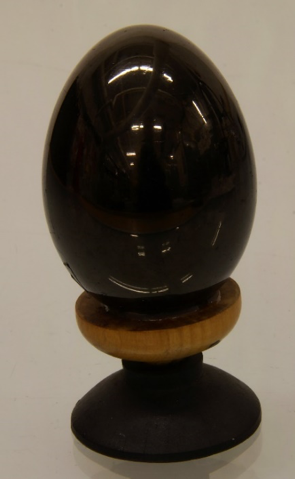On May 10th a new temporary exhibit is scheduled to be installed in Wertz Gallery: Gems and Jewelry that will feature gemstones, cabochons, polished spheres and carvings made from minerals unearthed in our own state of Pennsylvania. While we may be known as a coal producing state, there are lapidary and faceting grade minerals that are found in Pennsylvania as well. And, believe it or not, one of the polished pieces in the exhibit is a type of coal known as JET.

The English noun “Jet” derives from the French word for the same material: jaiet (modern French “jais”). The adjective “jet-black,” meaning as dark a black as possible, derives from this material.
Another unusual piece in the exhibit is a carving of an elephant made from a translucent variety of ANTIGORITE known as WILLIAMSITE which is found in the State Line Chromite District in Lancaster County.

WILLIAMSITE was named in 1848 in honor of its discoverer, Lewis White Williams, a mineralogist and geologist of West Chester, Pennsylvania.
I don’t want to give away too much because I want you to come the museum to see the exhibit in person, but I will reveal two other pieces. They were personally collected at the Bingham Mine in Hamiltonban Township, Adams County, by the 1988 Carnegie Mineralogical Award winner, John Sinkankas, who also cut and polished them. The colors in these cabochons are due to the epidote and cuprite in the META-RHYOLITE, which is a silicified, or metamorphosed, RHYOLITE (an extrusive igneous rock).


Besides those pieces mentioned here, you will also see faceted gemstones of QUARTZ, AMETHYST, SMOKY QUARTZ, AQUAMARINE, and TITANITE; cabochons of MALACHITE, BLUE QUARTZ, SUNSTONE, and AMAZONITE; and polished spheres of COPPER & QUARTZ, and BLUE QUARTZ. The Cut and Polished Pennsylvania Gems and Minerals will be on exhibit in Wertz Gallery at least through the end of summer. Don’t miss it!
Debra Wilson is the Collection Manager for the Section of Minerals at Carnegie Museum of Natural History. Museum employees are encouraged to blog about their unique experiences and knowledge gained from working at the museum.
